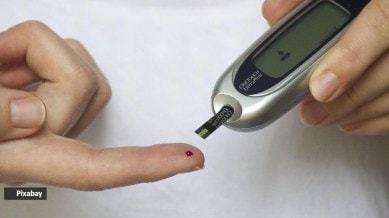📣 For more lifestyle news, click here to join our WhatsApp Channel and also follow us on Instagram
‘My fasting sugar is 106, and my PP is 149; is my sugar too high?’
Many people wait until their sugar levels rise even higher before taking action -- do not make that mistake

We have been providing you with insightful information on all aspects of blood sugar management for the past few weeks. In continuation, when we came across a Quora question asking ‘My fasting sugar is 106, and my PP is 149. Is my sugar too high?’, we turned to experts to better comprehend the scenario.
Fasting sugar of 106 mg/dl and post-meal sugar of 149 mg/dl are slightly above the normal range but not very high, said Dr Vijay Negalur, HOD, diabetology, KIMS Hospitals, Thane, adding that the sugar numbers are in the “grey zone”. “They are not quite diabetic, but they aren’t completely normal either,” said Dr Negalur.
monthly limit of free stories.
with an Express account.
Notably, for fasting blood sugar (FBS), a level below 100 mg/dL is considered normal. “A level between 100 and 125 mg/dl indicates ‘prediabetes,’ which means your body is showing early signs of insulin resistance. At 106, you are just above the normal cutoff,” explained Dr Negalur.
For postprandial (PP) sugar, measured two hours after a meal, the normal range is under 140 mg/dl. “A level between 140 and 199 mg/dl points to prediabetes, while 200 mg/dl or above confirms diabetes. Your PP reading of 149 is slightly above the normal range, suggesting a tendency towards prediabetes,” said Dr Negalur.
The good news is that these numbers are not alarming, but they serve as a timely wake-up call. “Many people wait until their sugar levels rise even higher before taking action. At this stage, simple lifestyle changes can make a big difference and even reverse the trend,” said Dr Negalur.
What helps?
With regular exercise, a balanced diet, and proper medicines, these values can be improved further,” said Dr Aarti Ullal, physician and diabetologist, Gleneagles Hospital, Parel, Mumbai.
Diet: Reduce refined carbs, sugary snacks, and processed foods. Prioritize high-fiber foods, vegetables, whole grains, pulses, nuts, and sufficient protein.
Try to eat smaller meals more often, avoid excess carbs and sugars, and include more fibre and proteins. “Walking after meals, proper sleep, and stress control also help. Always monitor your sugar levels and stay in touch with your doctor. Be extra cautious when it comes to your health. Follow the guidelines given by the doctor and you will surely notice the difference,” said Dr Ullal.
Exercise: Just 30 minutes of brisk walking, five days a week, can significantly improve insulin sensitivity.
Maintain a healthy weight, aim for 7 to 8 hours of quality sleep, and effectively manage stress. Poor sleep and high stress can lead to increased sugar levels.
Additionally, Dr. Negalur advised repeating the test in a month to confirm and getting an HbA1c test, which shows a three-month average of your sugar control. “If you have a family history of diabetes, high blood pressure, or obesity, pay even closer attention,” said Dr Negalur.
DISCLAIMER: This article is based on information from the public domain and/or the experts we spoke to. Always consult your health practitioner before starting any routine.
📣 For more lifestyle news, click here to join our WhatsApp Channel and also follow us on Instagram